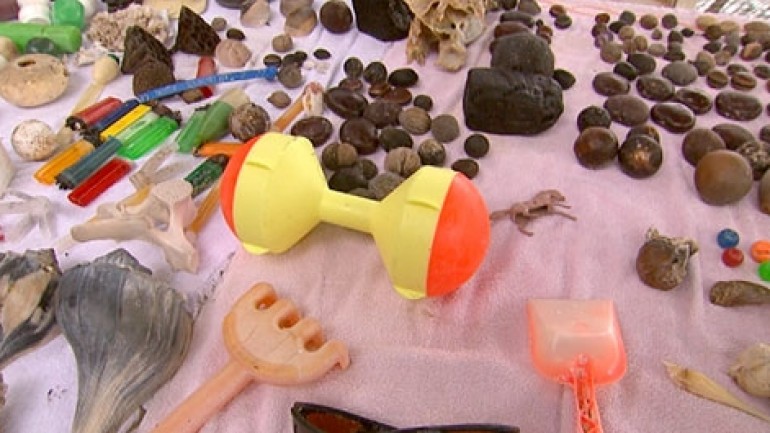What 29,000 Lost Toys Have Told Us About Our Oceans? Our oceans sure look pretty from afar, but if you take a closer look, you’ll find plenty of gross stuff lurking around. There are as many as 46,000 pieces of plastic floating in each square mile of ocean, threatening the health of our seas, especially the marine wildlife inhabiting them.
But there is at least one good thing scientists can get from all this junk: a better understanding of the behavior of complicated ocean currents, which are shaped by a number of disparate forces and affect, among other things, the climate and the distribution of Earth’s life forms. By studying the movement of ocean flotsam—in particular, the movement of 29,000 bathtub toys that were lost from a cargo ship in 1992—retired oceanographer Curtis Ebbesmeyer has uncovered quite a bit about our ocean’s currents and the places they carry litter.
Join WIRED Science host Ziya Tong as she and Ebbesmeyer explore the mysteries of surface currents and discover just how much bathtub toys and messages-in- bottles can tell us about our beloved oceans. Learn, too, about a section of the ocean appropriately called the “Great Garbage Patch” and about a piece of software called OSCURS that can determine, from just its starting point and date, exactly where a lost piece of plastic will end up years later.




I dont remember the last time I ever cried, I seriously shed a tear watching that. Does this make me gay?
it is so sad it makes me think “fuck it” we have destroyed the beautiful Earth, just take us plague and destroy us.
But there is a TON of social and consumer programming, but over all, it ends with people whom just don’t give a shit.
So here ya go people, just that cigarette butt out the window or jack in the box cup out the window or overboard. Just that once times a billion people makes this happen.
We ALL ought to be so very ashamed.
6/10
– Covers (1) Modelling ocean currents using traceable trash spills (cargo ships losing relatively unique and identifiable loads of flotsam such as shoes or toy ducks) (2) “3D fire fighting” – Concentrating not only on the fuel surfaces where the fire rises, but the air above it as well, e.g. using fans to remove smoke.
– This show just appears to be an episode of a science-related show, so each point is covered in shallow detail and briefly (suitable for a general audience with high school education). This isn’t what I had in mind when I consider what a Documentary is supposed to be, but it’s pretty close.
– Both of the topics (1) and (2) mentioned above seem like old stories to me. The ocean modelling strategy was even mentioned during the show as new in the late 90’s, while 3D Firefighting (via wikipedia) is considered even older. Considering this episdode of “Wired Science” was aired in 2007, I’m a bit surprised they covered these topics, but I don’t recall them stressing the ideas as new, so I guess that’s fine.
– Playback stopped for me at 19minutes, so I can not comment on the other topics covered. If I were to rate it based on the amount I viewed, I’d give it a 7/10 as a science show, but a 5/10 as a documentary.
6/10
– Covers (1) Modelling ocean currents using traceable trash spills (cargo ships losing relatively unique and identifiable loads of flotsam such as shoes or toy ducks) (2) “3D fire fighting” – Concentrating not only on the fuel surfaces where the fire rises, but the air above it as well, e.g. using fans to remove smoke.
– This show just appears to be an episode of a science-related show, so each point is covered in shallow detail and briefly (suitable for a general audience with high school education). This isn’t what I had in mind when I consider what a Documentary is supposed to be, but it’s pretty close.
– Both of the topics (1) and (2) mentioned above seem like old stories to me. The ocean modelling strategy was even mentioned during the show as new in the late 90’s, while 3D Firefighting (via wikipedia) is considered even older. Considering this episdode of “Wired Science” was aired in 2007, I’m a bit surprised they covered these topics, but I don’t recall them stressing the ideas as new, so I guess that’s fine.
– Playback stopped for me at 19minutes, so I can not comment on the other topics covered. If I were to rate it based on the amount I viewed, I’d give it a 7/10 as a science show, but a 5/10 as a documentary.
I’ve been scouting around on the web for finding a high quality examine about the following point . Looking in Aol I eventually noticed this nice site. After reading this info I am significantly completely satisfied to convey that I have a wonderful impression I stubled onto exactly what I needed. I most definitely will make certain to don’t overlook this net-website and look consistently.